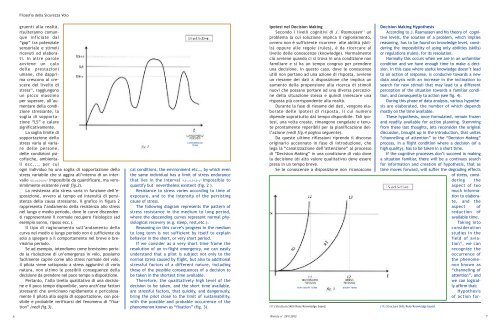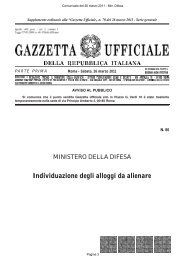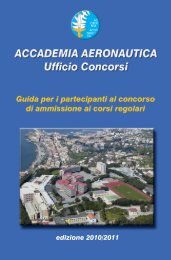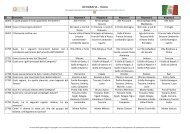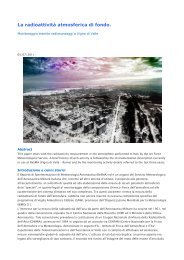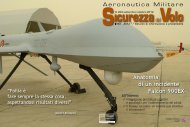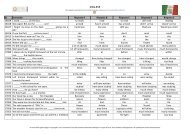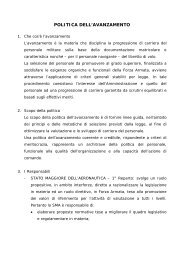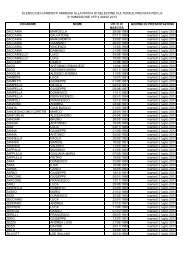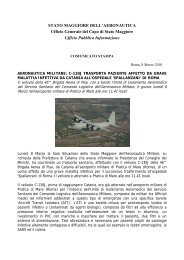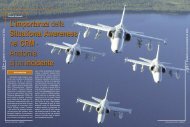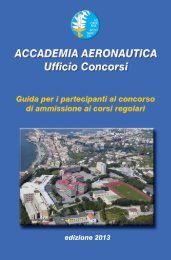Scarica l'intera rivista in formato pdf - Aeronautica Militare Italiana
Scarica l'intera rivista in formato pdf - Aeronautica Militare Italiana
Scarica l'intera rivista in formato pdf - Aeronautica Militare Italiana
You also want an ePaper? Increase the reach of your titles
YUMPU automatically turns print PDFs into web optimized ePapers that Google loves.
Filosofia della Sicurezza Volo<br />
gruenti alla realtà,<br />
risulteranno comunque<br />
<strong>in</strong>ficiate dal<br />
“gap” tra potenziale<br />
sensoriale e stimoli<br />
ricevuti ed elaborati.<br />
In altre parole<br />
avviene un calo<br />
delle prestazioni<br />
umane, che dapprima<br />
crescono al crescere<br />
del livello di<br />
stress 10 , raggiungono<br />
un picco massimo<br />
per superare, all’aumentare<br />
della condizione<br />
stressante, la<br />
soglia di sopportazione<br />
“LS” e calare<br />
significativamente.<br />
La soglia limite di<br />
sopportazione dello<br />
stress varia al variare<br />
delle persone,<br />
delle condizioni psicofisiche,<br />
ambientali<br />
ecc..., per cui<br />
ogni <strong>in</strong>dividuo ha una soglia di sopportazione dello<br />
stress variabile che si aggira all’<strong>in</strong>terno di un <strong>in</strong>tervallo<br />
”ع+LSع-LS“ impossibile da quantificare, ma verosimilmente<br />
esistente (vedi fig.2).<br />
La resistenza allo stress varia <strong>in</strong> funzione dell’esposizione,<br />
ovvero al tempo ed <strong>in</strong>tensità di persistenza<br />
della causa stressante. Il grafico <strong>in</strong> figura 2<br />
rappresenta l’andamento della resistenza allo stress<br />
nel lungo e medio periodo, dove le curve discendenti<br />
rappresentano il normale recupero fisiologico (ad<br />
esempio sonno, riposo ecc.).<br />
Il tipo di ragionamento sull’andamento della<br />
curva nel medio e lungo periodo non è sufficiente da<br />
solo a spiegare a il comportamento nel breve e brevissimo<br />
periodo.<br />
Se ad esempio, <strong>in</strong>tendiamo come brevissimo periodo<br />
la risoluzione di un’emergenza <strong>in</strong> volo, possiamo<br />
facilmente capire come allo stress normale del volo,<br />
il pilota viene sottoposto a stress aggiuntivi di varia<br />
natura, non ultimo le possibili conseguenze della<br />
decisione da prendere nel poco tempo a disposizione.<br />
Pertanto, l’alto livello qualitativo di una decisione<br />
e il poco tempo disponibile, sono anch’essi fattori<br />
stressanti che avvic<strong>in</strong>ano rapidamente e pericolosamente<br />
il pilota alla soglia di sopportazione, con possibile<br />
e probabile verificarsi del fenomeno di “fixation”<br />
(vedi fig.3).<br />
LONG/MEDIUM<br />
TERM<br />
cal conditions, the environment etc…, by which even<br />
the same <strong>in</strong>dividual has a limit of stress endurance<br />
that lies <strong>in</strong> the <strong>in</strong>terval ”ع+LSع-LS“ impossible to<br />
quantify but nevertheless existent (fig. 2 ).<br />
Resistance to stress varies accord<strong>in</strong>g to time of<br />
exposure, and to the <strong>in</strong>tensity of the persist<strong>in</strong>g<br />
cause of stress.<br />
The follow<strong>in</strong>g diagram represents the pattern of<br />
stress resistance <strong>in</strong> the medium to long period,<br />
where the descend<strong>in</strong>g curves represent normal physiological<br />
recovery (e.g. sleep, rest,etc.).<br />
Reason<strong>in</strong>g on this curve’s progress <strong>in</strong> the medium<br />
to long term is not sufficient by itself to expla<strong>in</strong><br />
behavior <strong>in</strong> the short, or very short period.<br />
If we consider as a very short time frame the<br />
resolution of an <strong>in</strong>-flight emergency, we can easily<br />
understand that a pilot is subject not only to the<br />
normal stress caused by flight, but also to additional<br />
stressful factors of a different nature, <strong>in</strong>clud<strong>in</strong>g<br />
those of the possible consequences of a decision to<br />
be taken <strong>in</strong> the shortest time available.<br />
Therefore, the qualitatively high level of the<br />
decision to be taken, and the short time available,<br />
are stressful factors, that quickly, and dangerously,<br />
br<strong>in</strong>g the pilot close to the limit of susta<strong>in</strong>ability,<br />
with the possible and probable occurrence of the<br />
phenomenon known as “fixation” (fig. 3).<br />
Ipotesi nel Decision Mak<strong>in</strong>g<br />
Secondo i livelli cognitivi di J. Rasmussen 11 un<br />
problema la cui soluzione implica il ragionamento,<br />
ovvero non è sufficiente ricorrere alle abilità (skills)<br />
oppure alle regole (rules), è da ricercare al<br />
livello delle conoscenze (knowledge). Normalmente<br />
ciò avviene quando ci si trova <strong>in</strong> una condizione non<br />
familiare e si ha un tempo congruo per prendere<br />
una decisione. In questo caso, dove le conoscenze<br />
utili non portano ad una azione di risposta, avviene<br />
un riesame dei dati a disposizione che implica un<br />
aumento della propensione alla ricerca di stimoli<br />
nuovi che possano portare ad una diversa percezione<br />
della situazione stessa e qu<strong>in</strong>di <strong>in</strong>nescare una<br />
risposta più corrispondente alla realtà.<br />
Durante la fase di riesame dei dati, vengono elaborate<br />
delle ipotesi di risposta, il cui numero<br />
dipende soprattutto dal tempo disponibile. Tali ipotesi,<br />
una volta create, rimangono congelate e tenute<br />
prontamente reperibili per la pianificazione dell’azione<br />
(vedi fig.4 pag<strong>in</strong>a seguente).<br />
Da queste ultime riflessioni riprendo il discorso<br />
orig<strong>in</strong>ario accennato <strong>in</strong> fase di <strong>in</strong>troduzione, che<br />
lega la “canalizzazione dell’attenzione” al processo<br />
di “Decision Mak<strong>in</strong>g” <strong>in</strong> una condizione di volo dove<br />
la decisione (di alto valore qualitativo) deve essere<br />
presa <strong>in</strong> un tempo breve.<br />
Se le conoscenze a disposizione non riconoscono<br />
VERY SHORT TERM<br />
SHORT TERM<br />
Decision Mak<strong>in</strong>g Hypothesis<br />
Accord<strong>in</strong>g to J. Rasmussen and his theory of cognitive<br />
levels, the solution of a problem, which implies<br />
reason<strong>in</strong>g, has to be found on knowledge level, consider<strong>in</strong>g<br />
the impossibility of us<strong>in</strong>g only abilities (skills)<br />
or regulations (rules), for its resolution.<br />
Normally this occurs when we are <strong>in</strong> an unfamiliar<br />
condition and we have enough time to make a decision.<br />
In this case where useful knowledge doesn’t lead<br />
to an action of response, is conducive towards a new<br />
data analysis with an <strong>in</strong>crease <strong>in</strong> the <strong>in</strong>cl<strong>in</strong>ation to<br />
search for new stimuli that may lead to a different<br />
perception of the situation towards a familiar condition,<br />
and consequently to action (see fig. 4).<br />
Dur<strong>in</strong>g this phase of data analysis, various hypothesis<br />
are elaborated, the number of which depends<br />
mostly on the time available.<br />
These hypothesis, once formulated, rema<strong>in</strong> frozen<br />
and readily available for action plann<strong>in</strong>g. Stemm<strong>in</strong>g<br />
from these last thoughts, lets reconsider the orig<strong>in</strong>al<br />
discussion, brought up <strong>in</strong> the <strong>in</strong>troduction, that unites<br />
“channell<strong>in</strong>g of attention” to the “Decision Mak<strong>in</strong>g”<br />
process, <strong>in</strong> a flight condition where a decision (of a<br />
high quality), has to be taken <strong>in</strong> a short time.<br />
If the cognitive processes don’t succeed <strong>in</strong> mak<strong>in</strong>g<br />
a situation familiar, there will be a cont<strong>in</strong>uos search<br />
for <strong>in</strong>formation and creation of hypothesis, that as<br />
time moves forward, will suffer the degrad<strong>in</strong>g effects<br />
of stress, consider<strong>in</strong>g<br />
the<br />
aspect of too<br />
much <strong>in</strong>formation<br />
to elaborate,<br />
and the<br />
aspect of<br />
reduction of<br />
available time.<br />
Tak<strong>in</strong>g <strong>in</strong>to<br />
consideration<br />
studies <strong>in</strong> the<br />
field of aviation<br />
12 , we can<br />
recognize the<br />
occurrence of<br />
the phenomenon<br />
known as<br />
“channel<strong>in</strong>g of<br />
attention”, and<br />
we can logically<br />
affirm that:<br />
Hypothesis<br />
of action for-<br />
(11) Struttura Skill/Rule/Knowledge based. (11) Structure Skill/Rule/Knowledge based.<br />
6<br />
Rivista n° 291/2012<br />
7


